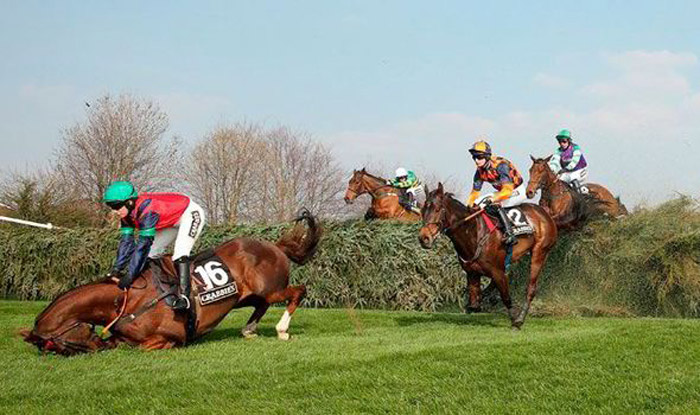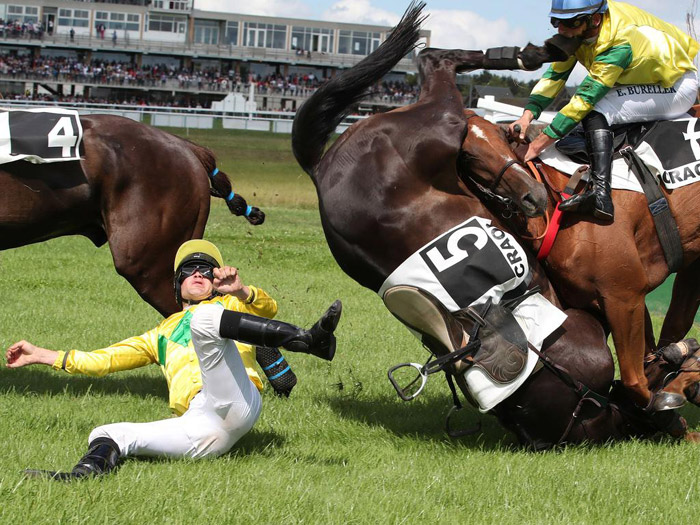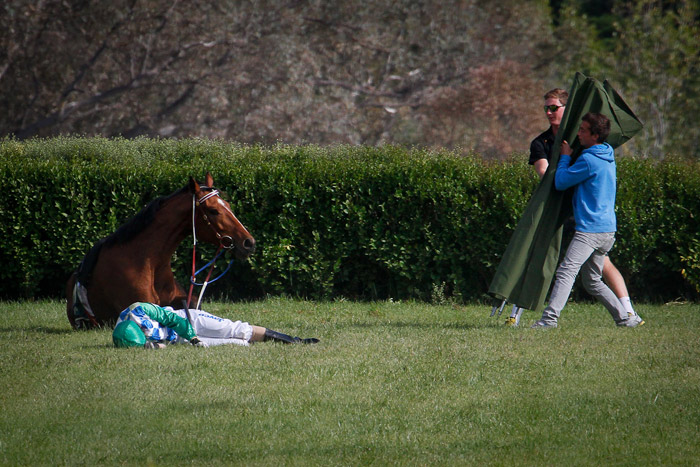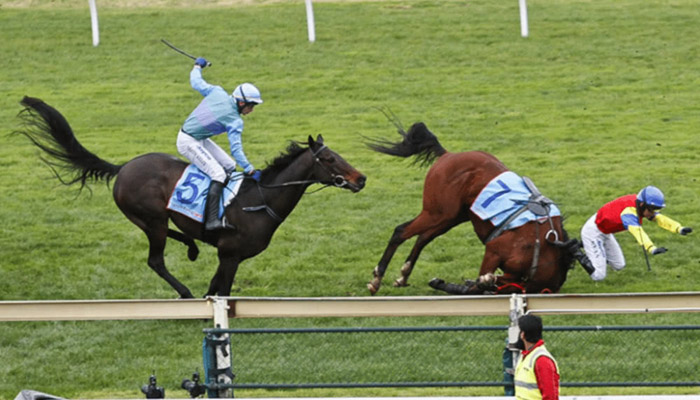Merseyside Animal Rights is opposed to all horse racing. It is inherently cruel, unnatural and dangerous to force animals to take part in such events.
However there is a world famous race which takes place right on our Liverpool doorsteps. The Grand National is the most valuable jump race in Europe, with a prize fund of £1 million. An event that is prominent in local and British culture, the race is popular amongst many people who do not normally watch or bet on horse racing at other times of the year. Particularly on Merseyside, the event is a huge social occasion, which brings a lot of people into the city centre to watch it in bars, while large numbers of people attend the event with their colleagues, it having become something of a works day out. People dress up for it, they place bets, they make a weekend of it.
It is also infamous for the number of horse fatalities which occur during the main race, and in other races that take place at Aintree over the weekend. Modern steeplechase races have an average of just over 4 equine fatalities for every 1,000 horses taking part, according to the British Horseracing Authority. However, the Grand National yielded 7 fatalities out of 439 horses taking part between 2000 and 2010. Those who fall are hastily covered with a green tarpaulin and disposed of, away from the public eye, masking the sport’s distressing reality from many spectators.
During the 1970s and 1980s, the Grand National saw a total of 12 horses die (half of which were at the Becher’s Brook jump); in the next 20-year period from 1990 to 2010, there were 17 equine fatalities. League Against Cruel Sports counts the number of horse deaths over the three-day meeting since the year 2000 at 59, 15 of which were in the main race. In 2021 one horse, The Long Mile, was euthanised after the race after suffering a broken leg on a flat section between fences. Two more were euthanised after suffering injuries in the 2022 event – Eclair Surf fell and suffered a head injury, whilst Discorama had suffered a pelvic injury. Two other horses died in other races held at Aintree over the same weekend.
While course officials have repeatedly taken safety measures over the years, such as improving veterinary facilities and reducing the severity of fences in an attempt to reduce the number of fatalities, the death toll has continued to mount up. The race clearly cannot be reformed; it is deliberately hazardous. It is run over an exhausting four-and-a quarter miles (an increase on years gone by) and has 30 fences that the horses are forced to jump. The event has seen numerous horses collapse at the end of the race, some of whom have died. Since 2000 there has been a crowded field of 40 horses. This makes the race much more dangerous than in former years when the mean field size between 1839 and 2000 was 29.
One of the most horrifying aspects of watching the Grand National is seeing jockeys furiously whipping their horses in a bid to make them gallop faster. While a law was brought in in 2011 to limit the number of times a jockey can use their whip, this misses the fundamental point that whipping an animal is cruel, no matter how many times you do it. Riders at the Grand National are actually required to carry whips, despite the RSPCA’s verdict that ‘using whips can cause pain and suffering to the horses’ and often makes them run beyond their natural capability, increasing the likelihood of accidents. Frequently, jockeys violate the already watered-down whipping regulations. The BHA backtracked after jockeys refused to abide by the new rules and the former restrictions on whip strikes became merely a guideline, leaving horses who are repeatedly hit vulnerable to the subjective discretion of the stewards as to whether or not they have been abused. The punishment regime was also greatly weakened, allowing jockeys an almost free rein to beat their mounts into submission. Television viewers were especially distressed to see the 2011 Grand National winner Ballabriggs being thrashed at the end of a race that left him so exhausted that he needed oxygen. His jockey, Jason Maguire, was banned from racing for five days but kept his prize money and his winner’s position. In August 2017, jockey Davy Russell was given a four-day suspension for punching a horse on the back of the head before a race at Tramore. Russell won the Grand National the following year. This is just more proof that the industry turns a blind eye to horses’ suffering.
Despite numerous changes to the course and conditions of the race, it remains a killer. Reducing the length of the race and the number of horses entered would make the event a typically hazardous event that would still kill horses. When a race passes without a fatality, it is due to good fortune rather than good planning. One horse death is too many. For this reason we call for the Grand National, the world’s most dangerous horse race, to be ended., along with jump racing in general.
Horses are not objects for human entertainment and they suffer greatly in the pursuit of our ‘fun’. If you love horses, don’t contribute to their suffering by supporting an industry that has no regard for their welfare. Please boycott the Grand National and all other horse races.
Sanctuary Not Cruelty is a campaign by Animal Aid that encourages would-be punters to take the money they would spend on betting and donate to horse sanctuaries instead. Two such sanctuaries are Horse and Farm Animal Sanctuary and The Racehorse Sanctuary.
We will be protesting opposite Aintree Racecourse (as you come out of the train station) from Thursday April 11th till Saturday April 13th, 11am-2pm every day
https://www.animalaid.org.uk/the-issues/our-campaigns/horse-racing/sanctuary-not-cruelty/
Other race horse facts:
Forcing horses to run at breakneck speed around a course deliberately designed to be hazardous is a recipe for disaster. Horses killed on racecourses may suffer from a broken leg, back, neck or pelvis, spinal injuries, heart attack or burst blood vessels. Up to 75% of race horses suffer from bleeding lungs, which can cause blood to leak from their nostrils. Gastric ulcers are present in around 93% of horses in training, in whom the condition gets progressively worse. When horses are retired, the condition improves.
The majority of deaths are by euthanasia following fractures, often on the scene in front of horrified spectators. 79% of deaths are estimated to come from musculoskeletal fractures and 12% from cardiopulmonary conditions. Horses weigh upwards of 1,000 pounds (450kg) and their ankles are surprisingly slender, no bigger than an average human male. They are forced to run at up to 30 miles per hour and jump over obstacles, all while being whipped and carrying a human on their back. In addition, the animals begin their ‘training’ while their skeletal systems are still growing, putting extra pressure on their bodies and leaving them often unprepared physically for the immense demands of high-speed racing. It can be difficult for veterinarians to diagnose injuries that are easily overlooked such as strained tendons or hairline fractures, and horses are often returned to training with these minor ailments that turn deadly on the racetrack. Horses may be drugged to mask the pain of existing injuries and conditions, keeping them running when they should be resting or receiving treatment. Owners don’t want to pay the fees for expensive surgeries, which horses often do not do well at, and so they usually deem them no-hopers and opt for euthanasia or sell the animals at auction—the ultimate betrayal for these beautiful and loyal animals.
When they get too old or stop performing well enough to be profitable, few racehorses are retired to pastures, despite what the industry would have us believe, because owners don’t want to pay for a horse who doesn’t bring in any money. On the whole it is private individuals (a third party) who take on the responsibility for unwanted horses after they leave racing – that is, if the horses are lucky enough to find a ‘home’ and even this may not be for a full-life duration, putting responsibility on others rather than the industry itself, leaving the 7,500 horses who leave racing each year in a precarious position.
Many racehorses end up in slaughterhouses where they are turned into dog food and glue. Approximately 1,000 horses from the industry are killed in abattoirs in Britain every year and turned into dog food or cheap meat, while others face horrific live-export journeys to Europe. An investigation by Animal Aid found that at least 4,000 retired racehorses had been slaughtered in abattoirs during a two-year period since 2019. These included horses which ‘had previous illustrious racing careers’. They set up hidden cameras at a slaughterhouse during the investigation which showed that on at least 26 occasions, horses at the abattoir were killed within sight of each other which is a breach of the regulations concerning slaughter.
As a result of the investigation, a new ruling in 2022 states that horses that are trained and entered to race in Britain must now be signed out of the human food chain. Animal Aid wants the government to go further and to introduce limits on the numbers of horses who can be produced, because this will result in fewer unwanted horses. Breeding females are subjected to drugs and prolonged periods of artificial light to control and speed up reproduction. Left to their own devices, mares in the wild have one foal every two years, or perhaps twice every three years. They deliver in the spring, after a pregnancy lasting 11 months. The racing industry can force healthy and fertile mares to produce a foal every year.
Horses don’t enjoy the ordeal of racing or get a thrill out of crossing the finishing line. They are whipped into submission and end each race sweating and exhausted, often with debilitating injuries – if they survive at all. Victims of a multi-million-pound industry, horses all too often pay the ultimate price. Whether they die in terrifying accidents on the track or in training, are euthanised after sustaining crippling injuries, or fail to win races and are shipped off to an abattoir, these sensitive animals are treated as nothing more than disposable commodities, not sensitive, sentient beings. The owners of horses made to run in the Grand National often claim that they love these animals. But since they’re willing to subject them to all the abuse and suffering described above, it’s clear that what they truly love is money and glory.
We want to see an end to all horse racing, because it is an intrinsically cruel and exploitative industry, which fails to take care of horses when they are deemed to no longer be of use. Please do not support the industry by betting on horses or attending racecourses.
Animal Aid have launched Race Horse Death Watch – the only public record of the names and details of horses who were killed on all British racecourses.
https://www.horsedeathwatch.com
We will be protesting opposite Aintree Racecourse (as you come out of the train station) on Saturday April 15th, 11am-2pm.
People are welcome to arrive earlier as Animal Rising are planning leafleting from 09:30 and some people may be staying until the Grand National itself at 5.15pm. We will also do some leafletting outside Aintree on Friday 14th - Ladies Day 12-2pm.



